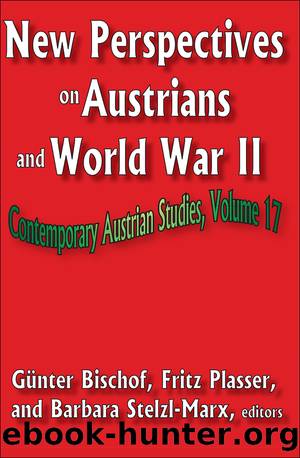New Perspectives on Austrians and World War II by Fritz Plasser

Author:Fritz Plasser [Plasser, Fritz]
Language: eng
Format: epub
Tags: History, Europe, Western, Military, World War II, Austria & Hungary, Political Science, International Relations, General
ISBN: 9781412808835
Google: ysMmmAEACAAJ
Publisher: Transaction Publishers
Published: 2009-01-15T01:45:27+00:00
Memories and Narratives about the Expulsion from Vienna and Immigration to the United States
With the takeover of the National Socialist party in March 1938, cruel persecution against the Austrian Jewish populationâsuch as deprivation of rights, plunder and Aryanization, expulsion, and annihilation politicsâbegan which the Austrian population hardly resisted.28 The racial Nuremberg Laws (1935) affected approximately 206,000 persons in Austria.29 That share represented around 3 percent of the total Austrian population at the time. The traditional center of Jewish life in Austria was Vienna where 92 percent of the Jewish population lived. In the narrations of the interviewees, one can notice the sense of powerlessness they experienced in those days. Richard Wellish, then seventeen years old, remembers his feelings at the time of the Anschluss:
I remember the smell of the air, it was early spring, it was wonderful, the juices were flowing, and who could resist the savior, the savior who would throw you in the mud, within less than ten years, you were down and out. Unbelievable the atmosphere [â¦] to be there at one of the warmest days after a bitter winter and to speak, open all the pores and let the sunshine in, not realizing, that the sunshine was poisoned.30
Kurt Elias had a quite similar sensation in spring 1938âdawn of nature versus breakdown of his own young life: âThe thirteenth was an outrageously beautiful day and I went for a walk in Vienna and I got to Heldenplatz and the lilacs were in full bloom and my first thought was, damn, how can the lilacs bloom when my life is collapsing; thatâs an outrage.â31 Edmund Engelmann, the photographer who secretly took pictures of Sigmund Freudâs apartment in Vienna 1938 when Freud had already left for London, expressed in his narration the feeling of being helpless to which the Jewish population was permanently exposed:
There was the feeling that they had no right to do what they were doing, that anyone could do whatever they wanted with you; that is something indescribable. You spend your whole life being a decent person, with values, with ideals, and all at once everyone is your enemy [â¦] I remember the story, every summer, when there wasnât much going on, there was an article in the newspaper with the title, âThe Golden-Hearted Viennese.â Pigeons that somehow got their foot stuck on the roof and couldnât get free, the fire department came and put up the ladder and the fireman went up and freed the pigeon, the golden-hearted Viennese, the golden-hearted Viennese tortured and stole from thousands.32
However, after the Anschluss, families of the interviewees suddenly realized that they had to leave, this was also the response in Josef Eisingerâs family:
The first thought was, how could we survive this? At the beginning, we didnât know that every possibility to earn money would disappear, and a holocaust, the killing of people because they were Jewishâwe never imagined all that would happen. Two or three years later, it was hard to believe, but people were starting to think of emigration, and a lot of people were taking retraining courses.
Download
This site does not store any files on its server. We only index and link to content provided by other sites. Please contact the content providers to delete copyright contents if any and email us, we'll remove relevant links or contents immediately.
Verus Israel: Study of the Relations Between Christians and Jews in the Roman Empire, AD 135-425 by Marcel Simon(568)
Phoenicians among Others: Why Migrants Mattered in the Ancient Mediterranean by Denise Demetriou(567)
Caesar Rules: The Emperor in the Changing Roman World (c. 50 BC â AD 565) by Olivier Hekster(548)
Europe, Strategy and Armed Forces by Sven Biscop Jo Coelmont(493)
Give Me Liberty, Seventh Edition by Foner Eric & DuVal Kathleen & McGirr Lisa(463)
Banned in the U.S.A. : A Reference Guide to Book Censorship in Schools and Public Libraries by Herbert N. Foerstel(461)
american english file 1 student book 3rd edition by Unknown(455)
Reading Colonial Japan by Mason Michele;Lee Helen;(452)
The Roman World 44 BC-AD 180 by Martin Goodman(450)
DS001-THE MAN OF BRONZE by J.R.A(436)
The Dangerous Life and Ideas of Diogenes the Cynic by Jean-Manuel Roubineau(427)
The Oxford History of World War II by Richard Overy(426)
Basic japanese A grammar and workbook by Unknown(426)
Introducing Christian Ethics by Samuel Wells and Ben Quash with Rebekah Eklund(425)
Imperial Rome AD 193 - 284 by Ando Clifford(424)
Literary Mathematics by Michael Gavin;(385)
Language Hacking Mandarin by Benny Lewis & Dr. Licheng Gu(364)
How to Reach the 9.0 in IELTS Academic Reading by IELTS Medical(349)
The Oxford History of the Renaissance by Campbell Gordon;(342)
